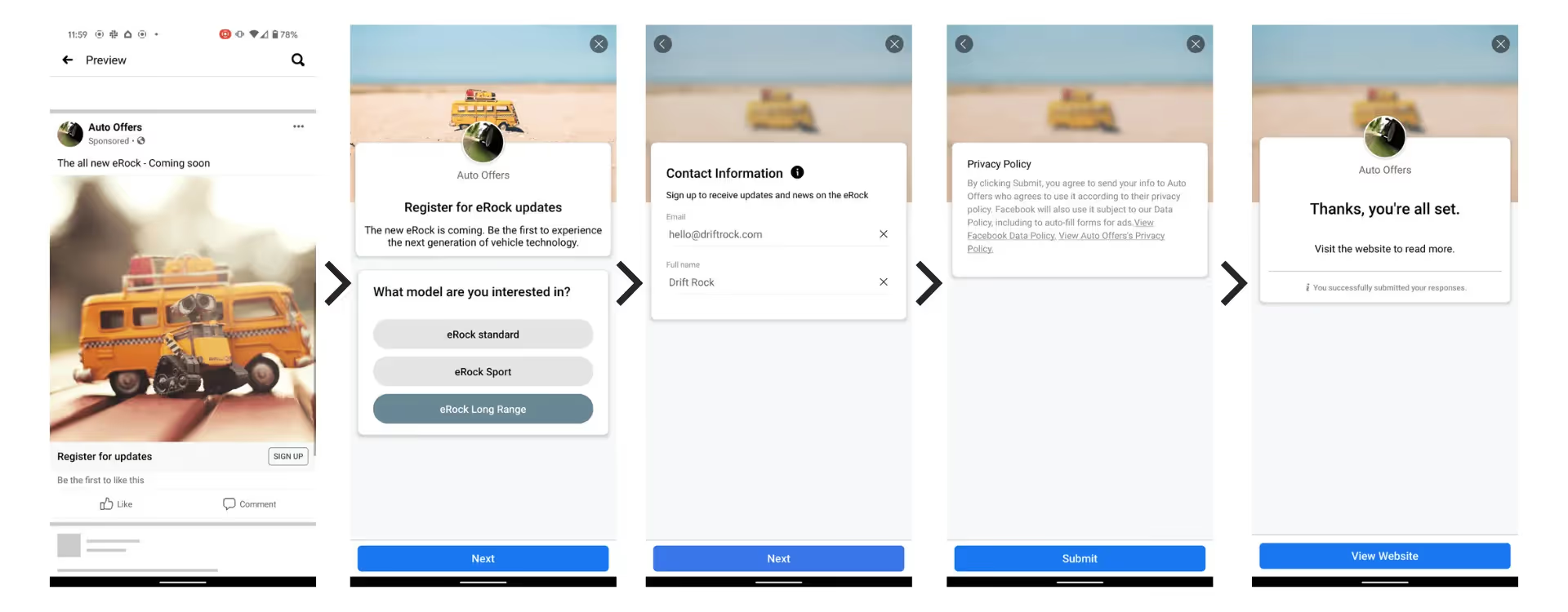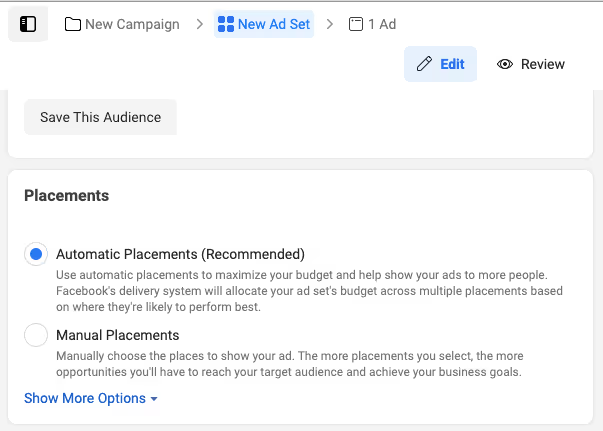
Conversation

🥳 Feedback Received!
Thanks for taking a moment to share your thoughts — it genuinely helps us make each chapter sharper.
What happens next:
- Your feedback goes straight to our product team.
- We’ll use it to refine lessons, clarify examples, and make the program even more useful.
Appreciate you helping make this program better for everyone.
Ready for your next challenge? 👇
Meta Ad Types
Meta Ads lets you run ads on both Facebook and Instagram.
This lesson explores:
- The structure of Meta Ads (campaigns, ad sets, ads),
- Key ad formats and placements
We’ll focus on modern formats and best practices, leveraging Meta’s Advantage+ AI for automation and optimization across platforms. Meta ads structure
Meta ads structure
Meta Ads are organized in three levels: the campaign, ad sets, and ads.

- Campaign: The top level, where you set your objective (e.g., Sales, Traffic, Engagement). We recommend the Sales objective (conversions) to focus on traceable actions tied to revenue (e.g., purchases, sign-ups). Advantage+ Sales campaigns automate most settings, making them ideal for beginners.
- Ad set: Groups of ads under a campaign, where you define your audience, budget, schedule, and placements. In Advantage+ campaigns, Meta’s AI handles audience targeting and placement, but you can refine with custom audiences or remarketing if needed after testing.
- Note in Google Search you define budgets and targeting at the Campaign level, in Meta Ads nearly all of that is defined at the Ad Set level.
- Ad: The individual creatives (images, videos, copy, CTAs) that users see, linked to a landing page or in-platform action (e.g., lead form). Ads within the same ad set should align with the same goal (e.g., driving e-commerce sales for landscaping equipment).
Understanding these levels is key, as we’ll use them throughout this module. Ad formats and placements vary, but Meta’s AI simplifies testing by optimizing across options.
Ad formats
Meta Ads support various formats, with visuals (images, videos) being the star of the show.
Here are the most effective formats:
NOTE: We go into way more detail into how to create great ads in the Ad Creative module!
Video ads
- Overview: Video ads are harder to make but often outperform static images—especially for their storytelling power and dynamism.
- Best for: Startups with visually engaging products or services. Some studies show that video ads work best for "hedonistic" or pleasure based products, whereas for more utilitarian products they have less of an impact.
- Examples of types of videos include:
- Customer testimonials: Users sharing how your product solved their problem
- Transformation videos: Before-and-after visualizations.
- Product demos: Short walkthroughs with captions or voiceovers (e.g., showing a SaaS tool’s UI).
- UGC-like videos: Where it looks like someone is talking about how much they love the product.
- Hype video: Rapid cut video featuring your product.
- Motion ads: A static creative that comes to life with some motion.
- Best practices:
- The first 3 seconds are the most important.
- Keep videos 15–30 seconds long to retain attention, per Meta’s 2025 recommendations.
- Use captions (85% of users watch without sound) and a compelling thumbnail.
- Optimize for mobile (4:5 or 1:1 aspect ratio for Feed, 9:16 for Stories/Reels).
- When to avoid: Honestly, with the power of smartphones and AI, basically everyone can create video ads these days. You can easily film UGC-style videos using a smartphone + Capcut, or do AI generated ads using Icon.
Image ads

- Overview: Single-image ads are simple to create and can still be very effective.
- Best for: Startups with limited creative resources or products that don’t require dynamic storytelling.
- Best practices:
- Use high-res images (e.g., 1080x1080 or 1200x628, 150 DPI)
- Experiment a ton with messaging, imagery, format, and more.
- Highlight a single benefit
- Optimize for 1:1 (Feed) or 4:5 (Stories) aspect ratios to ensure compatibility
Carousel ads

- Overview: Carousel ads display 3–10 images or videos in a swipeable format, ideal for showcasing multiple products or features in one ad.
- Best for: E-commerce startups with diverse products (e.g., landscaping tools, garden decor) or to highlight features of a single product (e.g., a lawn mower’s speed, battery life, eco-design).
- Best practices:
- Use 3–5 images/videos for optimal engagement—too many (e.g., 10) reduce completion rates.
- Start with a compelling first image and keep headlines concise
- Use a consistent visual theme (e.g., same color scheme, branding) across cards to maintain flow.
- Optimize for 1:1 aspect ratio for compatibility across Feed placements.
- Use the linear format to tell a story or highlight different value props.
Lead ads

- Overview: Lead ads use in-platform forms (e.g., on Facebook/Instagram) to capture user information without redirecting to a landing page, reducing friction for lead generation.
- Best for: Startups with high lifetime value (LTV) products/services (e.g., >$500 LTV) like B2B SaaS or services, where collecting leads and contacting them via sales is normal.
- Creatives are the same: Lead ads are just like static ads, it's just instead of a click going to a landing page, it goes to a form directly in Facebook or Instagram.
- Best practices:
- Use specific ad copy to attract the right audience (e.g., “Landscaping Pros: Get a Free Quote!” to target business owners, not DIY users).
- Keep forms short (3–5 fields, e.g., name, email, phone) to boost completion rates.
- Pair with remarketing to convert leads who don’t act immediately.
- Caution: Lead ads may generate lower-quality leads—use specific creatives and forms to filter for high-intent users.
Modern tip: Start with Video or Image ads for simplicity, testing Carousel or Lead ads after 30 days of data. Use Reels ads if targeting Instagram’s mobile-first audience with short, engaging content.
Placements
Meta Ads appear across various placements on Facebook and Instagram, with Advantage+ AI optimizing delivery. In 2025, the focus is on high-engagement placements, and Meta recommends Automatic Placements for startups.
Here are the key placements:
- News Feed (Facebook and Instagram): Ads appear in users’ main feeds, blending with organic content. Best for Image, Video, and Carousel ads, driving high visibility and engagement.
- Stories (Facebook and Instagram): Full-screen vertical ads (9:16) shown between users’ Stories, acting as a “commercial break.” Ideal for Video or Image ads, capturing immediate attention with interactive elements (e.g., polls, swipe-up CTAs).
- Reels (Instagram): Short-form video ads within Reels, highly engaging for mobile-first audiences. Best for vertical Video ads (9:16), leveraging trending audio or effects.
- Explore (Instagram): Ads in the Explore tab, reaching users discovering new content. Suits Image or Video ads targeting broad interests.
- Marketplace (Facebook): Ads in the Marketplace tab, ideal for ecomm startups targeting users browsing products.
Automatic Placements recommendation: Let Advantage+ AI select placements by enabling Automatic Placements in your campaign setup. Meta’s AI tests all options (Feed, Stories, Reels, etc.) in the first 14–30 days, prioritizing high-performing placements (e.g., Instagram Stories for a landscaping ad). Manual placements limit reach and efficiency—avoid them unless refining after 30+ days of data.

Final notes
Ads are all about experimentation—and that's the most true when it comes to ad creatives.
You'll always want to do a mix of images, carousels, and video ads to see what performs best.
Images are the easiest to create and iterate on, and videos have the highest potential for engagement.
Dive more into the Ad Creative module for our full recommendations.


